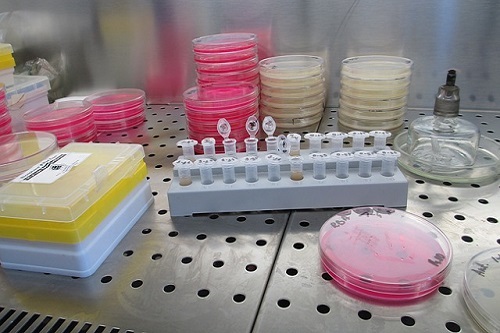CULTURE
Is the term given to microorganisms that are cultivated in the lab for the purpose of identifying and studying them.
MEDIUM
Is the term given to the combination of ingredients that will support the growth and cultivation of microorganisms by providing all the essential nutrients required for the growth in order to cultivate these microorganisms in large number to study them.
Reasons for bacterial cultural:
- Subsequent clinical diagnosis.
- Studying its morphology and its identification.
- Bacteria have to be cultured in order to obtain antigens from developing serological assay for vaccines. -Certain genetic studies and manipulations of the cells also need that bacteria can be cultured in vitro.
- Culturing on solid media is another convenient way of separating bacteria in mixture.

Composition of culture media
- Provide similar environmental and nutritional conditions that exist in its natural habitat.
- An artificial culture medium must provide all the nutritional components that a bacterium gets in its natural habitat.
- A culture medium contains water, a source of carbon & energy, source of nitrogen, trace elements and some growth factors.
- The pH of the medium must be set accordingly.
Classification
Bacterial culture media can be classified in at least three ways:
- CONSISTANCY
- NUTRITIONAL COMPONENT
- FUNCTIONAL USE
Classification based on consistency
- Liquid media: These are available for use in test-tubes, bottles or flasks. Liquid media are sometimes referred as “broths” (e.g nutrient broth). In liquid medium, bacteria grow uniformly producing general turbidity.
- Solid media: An agar plate is a Petri dish that contains a growth medium (typically agar plus nutrients) used to culture microorganisms. Agar is the most commonly used solidifying agent.
- Semi-solid agar: Such media are fairly soft and are useful in demonstrating bacterial motility and separating motile from non-motile strains Hugh & Leifson’s oxidation fermentation.
Classification based on nutritional component
- Simple media: Such as peptone water& nutrient agar can support most non-fastidious bacteria.
- Complex media: Such as blood agar have ingredients whose exact components are difficult to estimate.
- Synthetic media: Specially prepared media for research purposes where the composition of every component is well known.
Classification based on functional use or application
- Basal media
- Enriched media
- Selective media
- Enrichment media
- Differential media
- Indicator Medium
- Transport media
- Anaerobic media
BASAL MEDIA
Are basically simple media that supports most non-fastidious bacteria.
Examples of Basal media: Peptone water, nutrient broth and nutrient agar.
ENRICHED MEDIA
Addition of extra nutrients in the form of blood, serum, egg yolk etc to basal medium makes them enriched media .
Examples of Enriched media: Chocolate agar, Blood agar.
Chocolate Agar – Is a non-selective, enriched growth medium. Containing red blood cells that have been lysed by slowly heating to 80 °C. Chocolate agar is used for growing fastidious bacteria, such as Haemophilus influenzae .
Blood Agar – Blood agar plate (BAP) Contains mammalian blood (usually sheep or horse), typically at a concentration of 5– 10%. BAP are enriched, differential media used to isolate fastidious organisms and detect hemolytic activity.
SELECTIVE MEDIA
Enrichment media are designed to inhibit unwanted commensal or contaminating bacteria and help to recover pathogen from a mixture of bacteria.
Any agar media can be made selective by addition of certain inhibitory agents that don’t affect the pathogen. To make a medium selective include addition of antibiotics, dyes, chemicals, alteration of pH or a combination of these.
Examples of Selective media – Thayer Martin Medium selective for Neisseria gonorrhoeae , EMB agar is selective for gram-negative bacteria & Campylobacter Agar is used for the selective isolation of Campylobacter jejuni subsp. jejuni .
ENRICHMENT MEDIA
Liquid media that also serves to inhibit commensal in the clinical specimen.
Examples are Selenite F broth and alkaline peptone water.
DIFFERENTIAL MEDIA
Certain media are designed in such a way that different bacteria can be recognized on the basis of their colony colour. Various approaches include incorporation of dyes, metabolic substrates etc, so that those bacteria that utilize them appear as differently coloured colonies.
Example of differential media- MacConkey’s agar, CLED (cysteine lactose electrolyte deficient agar) agar, TCBS agar, XLD (xylose lysine deoxychocolate agar) agar, Fungal media- Dermatophyte test medium .
INDICATOR MEDIUM
These media contain an indicator which changes colour when bacteria grow on them.
Example- Wilson and Blair medium for isolation of Salmonella typhi and S. paratyphi .
TRANSPORT MEDIA
Clinical specimens must be transported to the laboratory immediately after collection to prevent overgrowth of contaminating organisms or commensals. This can be achieved by using transport media. Example of Transport media -Cary Blair medium for campylobacter species, Alkaline peptone water medium for v. cholerae.
ANAEROBIC MEDIA
Anaerobic bacteria need special media for growth because they need low oxygen content, reduced oxidation –reduction potential and extra nutrients. Media for anaerobes may have to be supplemented with nutrients like hemin and vitamin K. Boiling the medium serves to expel any dissolved oxygen
Example of Anaerobic media – Thioglycollate medium.






Be the first to comment